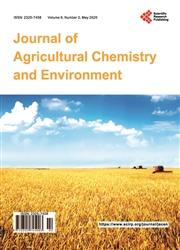Heavy Metal Fluxes in Tropical Urban Forest Soil in Abidjan District (Côte d’Ivoire)
引用次数: 1
Abstract
In Western Africa, the growth of cities has led to natural resource pollution, especially air pollution. Urban forests play a key role in filtering atmospheric particles and pollutants through the canopy before reaching the soil. This study aims to quantify heavy metal fluxes in an urban forest in the district of Abidjan in order to assess its role in the protection of natural resources. A monitoring of wet deposition (throughfall and open field rain) and litterfall was carried out for six months in the urban forest of the National Floristic Center located in Abidjan, C?te d’Ivoire. The results show that the soil of this urban forest is a ferralsol type characterized by a sandy-clay texture and a low load of coarse elements. The annual litterfall is estimated to 12.16 ± 0.71 t·ha-1·yr-1, similar to other tropical forests. Annual quantities of rain and throughfall are in the range of the rainfall recorded in the district of Abidjan (2013 ± 152 and 1773 ± 51 mm). Chemical analyses showed that litter and rainfall contain Mn, Zn, Ni, Cr, Cd and Hg. Manganese and Zn are the most abundant elements and Hg the least abundant in both rainfall and litter. The main source of input of the heavy metals into the urban forest soil is associated with biological recycling through the litter. The litterfall contributes to metal fluxes in soil 109 times greater than metal fluxes carry by wet depositions (open field rain and throughfall). However, a detailed study of rainfall showed that the forest canopy constitutes a barrier for the transfer of heavy metal to urban soil. This is indicated by a decrease in heavy metal content from open field rain to throughfall. Consequently, this study recommends the creation and maintenance of urban forests to increase biomass canopy and improve atmospheric air quality for West African cities undergoing constant change and development.阿比让地区热带城市森林土壤重金属通量(Côte科特迪瓦)
在西非,城市的增长导致了自然资源污染,尤其是空气污染。城市森林在过滤大气颗粒和污染物到达土壤之前发挥了关键作用。这项研究旨在量化阿比让地区城市森林中的重金属通量,以评估其在保护自然资源方面的作用。在位于科特迪瓦阿比让的国家植物学中心的城市森林中进行了为期6个月的湿沉降(穿透雨和露天雨)和凋落物监测。科特迪瓦。结果表明:该城市森林土壤为砂-粘土结构,粗质元素含量低的砂质土壤类型。年凋落物估计为12.16±0.71 t·ha-1·年-1,与其他热带森林相似。年降雨量和穿透量在阿比让地区记录的降雨量范围内(2013年±152毫米和1773±51毫米)。化学分析表明,凋落物和降雨中均含有Mn、Zn、Ni、Cr、Cd和Hg,其中锰和Zn含量最高,Hg含量最低。城市森林土壤重金属输入的主要来源与凋落物的生物循环有关。凋落物对土壤中金属通量的贡献是湿沉积(露地雨和雨水)携带的金属通量的109倍。然而,对降雨的详细研究表明,森林冠层构成了重金属向城市土壤转移的屏障。从露地雨到透雨的重金属含量下降表明了这一点。因此,本研究建议在不断变化和发展的西非城市中建立和维护城市森林,以增加生物质冠层和改善大气空气质量。
本文章由计算机程序翻译,如有差异,请以英文原文为准。
求助全文
约1分钟内获得全文
求助全文

 求助内容:
求助内容: 应助结果提醒方式:
应助结果提醒方式:


